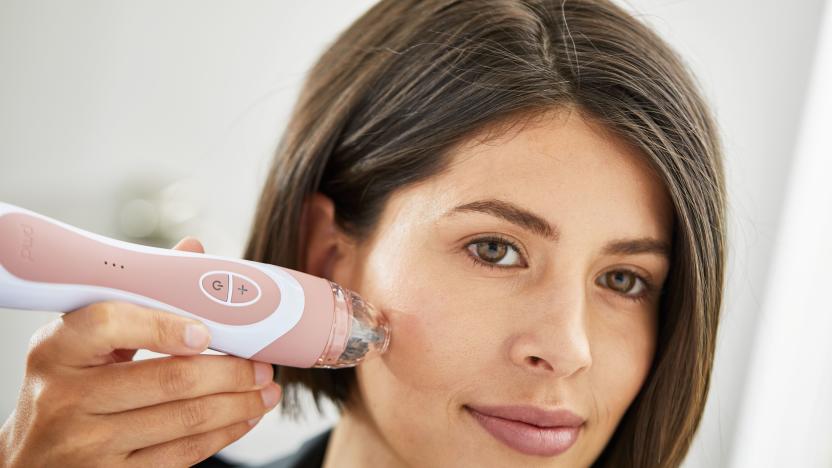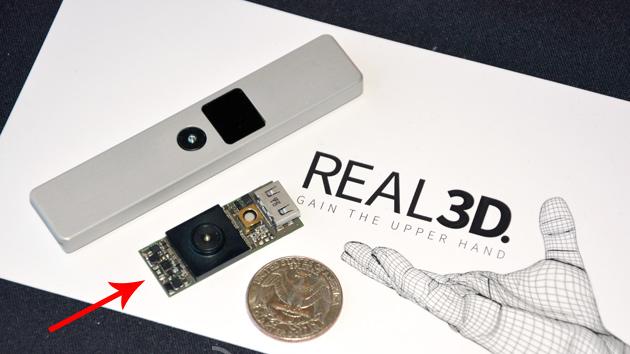PMD
Latest

What we bought: A microdermabrasion device to scrape off my skin
The PMD Beauty microdermabrasion device is a skincare tool I don't regret buying.

Touching virtual reality with Nimble VR's Sense camera
Every time I use virtual reality headsets, I find new limitations. Now that I'm finally "inside" a virtual world, I want to explore. I want to touch things and feel them respond. I want to speak and have my voice heard inside the virtual world. I want to see my hands represented virtually, and I want to be able to use them as I do in real life. I very much doubt I'm alone in this -- the latest Oculus Rift dev kit has a dedicated USB port on top of the headset explicitly for peripherals that intend to solve these issues. I spent an hour last week with one such device: the Nimble Sense camera from Nimble VR.

Exclusive: PMD's CamBoard Pico XS is the tiniest gesture camera we've ever seen (video)
Just as we were wrapping up CES today, we caught up with our friends over at PMD Technologies who surprised us with a little exclusive. What you see above is the new CamBoard Pico XS gesture camera that's dwarfed by the Pico S -- the one we saw at Computex -- next to it. This tiny module is only 4mm thick, 39.5mm long and 15.5mm wide, making it 1.5mm thinner and almost half as long as its predecessor, while still packing the same Infineon IRS1010C 3D image sensor chip. Given the size plus the fact that it already uses MIPI (Mobile Industry Processor Interface) instead of USB, the Pico XS is truly integration-ready for OEMs. The main changes that enabled this size reduction are the smaller lens -- which is compensated by a sharper laser illumination (but still 850nm infrared) -- plus the removal of the aluminum heat sink (which is actually the chassis), courtesy of a much lower power consumption. Instead of a typical 1W you get on the Pico S, the Pico XS requires less than 50mW typically (at 25fps) and 350mW max (up to 45fps). Temperature-wise it goes up by just 10 degrees Celsius at most, apparently. Despite the slightly reduced viewing angles, we've been told that this smaller depth camera offers the same performance as before. That certainly seems to be the case after this author tried it using PMD's Nimble UX middleware (co-developed by 3Gear Systems), which is able to do two-hand skeletal tracking down to finger level, as shown in our video after the break.

PMD's Nimble UX platform gives computers super accurate touchless gesture controls
Most of us are familiar with touchless gesture controls, thanks to the efforts of Leap Motion, SoftKinetic, PrimeSense and others. PMD, however, is a name you may not be familiar with, despite the fact that the German firm has been building some of the most accurate and robust depth sensing technology in the world for around a decade. The reason for its low profile? PMD's technology has been used almost exclusively in industrial and automotive settings... until now. The company began exploring consumer products back in 2009, and we saw its first consumer reference design sensor, the CamBoard Pico, last year at Computex. Now, the company's back with its sensor camera and a new gesture control platform for both Mac and PC, called Nimble UX. Nimble has three parts -- the first, as mentioned, is a depth-sensing camera. Next is the Nimble PMD SDK that gives developers access to the depth information gathered by the sensor and tools to help them build gesture-based applications. Finally, there's the Nimble dashboard, which is a plug-and-play bit of software that implements touchless gesture controls for Windows 8. We got to see Nimble UX for ourselves and chat with the folks from PMD to see what sets their technology apart from the competition, so join us after the break to learn more.

PMD and Infineon to enable tiny integrated 3D depth cameras (hands-on)
After checking out SoftKinetic's embedded 3D depth camera earlier this week, our attention was brought to a similar offering coming from Germany's PMD Technologies and Infineon. In fact, we were lucky enough to be the first publication to check out their CamBoard Pico S, a smaller version of their CamBoard Pico 3D depth camera that was announced in March. Both reference designs are already available in low quantities for manufacturers and middleware developers to tinker with over USB 2.0, so the two companies had some samples up and running at their demo room just outside Computex. %Gallery-190502%

Fruit Ninja meets real Ninja with CamBoard's Pico gesture camera (video)
You can play Fruit Ninja with your fingertips, you can play it with your eyes, so it's reasonable enough that hand waving should control it too. And while gesture-sensing technology is hardly new, Teutonic outfit pmdtechnologies has been teasing a miniaturized edition of its depth camera that's ripe for embedding into small consumer electronics devices. All we've got so far is a short video (after the break) outlining its potential, but that's enough to hope someone can go head-to-head with Microsoft in the space.

Samsung Galaxy Player 70 Dual Core hands-on (video)
Everything Samsung seems to be just a touch better in Seoul, and the South Korean giant's Galaxy Player 70 is no exception. For starters, it ships with a dual-core 1GHz processor -- a first for the WiFi-only Galaxy Player series. The 5-inch capacitive-touch LCD offers 800 x 480-pixel resolution, and can display whatever the Android 2.3 Gingerbread OS throws its way, but it also packs a unique Korea-only punch: a DMB TV tuner, for pulling in terrestrial programming only available in Samsung's home country. There's also a requisite 8-inch retractable antenna, in addition to the standard micro-USB port, microSD card slot, headphone jack, built-in mic and stereo speakers around back. Like most Samsung portables, it's also photo friendly, with a 5-megapixel camera with flash on the rear and a VGA cam up front. The 2500mAh battery isn't easily swappable, unfortunately, since the PMP's backplate is screwed to the housing.Considering that the Player is only going to be available for purchase in Korea, the only opportunity to go hands-on at this point is at Samsung HQ, which we just happen to be visiting this week. We spent some time with the device today, and while there's no chance of this iteration ever making an appearance on U.S. shores, we certainly wouldn't mind if it did. The plastic housing has the same look and feel as most other Galaxy devices, so there were no surprises there. It does bear a striking resemblance to the Galaxy S II, though the LCD here doesn't offer contrast or color reproduction that's anywhere close to the Super AMOLED Plus display on that record-breaking smartphone. Navigating the TouchWiz interface felt snappy, as it should given the processing duo on board, and the DMB television viewer worked flawlessly -- at least once we had a chance to take it away from the rumored-frequency-jamming R&D facility. Join us past the break for a closer look at the Galaxy Player 70 -- for those of you living outside of Korea, this may very well be your only chance.

Ripxx ski app out now for Android, still has no idea what the street value of this mountain is
The closest we have ever come to a ski race is the worn out VHS copy of Better Off Dead we still have in the back of our closets somewhere, but if you're an Android-lovin' ski bunny jealous of all the attention Ripxx has been giving the iPhone, you're in luck. That's right, your fave open source smartphone OS has its very own version of the Ripxx Ski and Snowboard app. Version 1.1 features over 200 mapped out resorts, GPS tracking, stats recording (including speed, distance, and vertical drop) and more. Not bad for $5, eh?

Ripxx ski app for iPhone great for athletes, useless for Epyx Winter Games
We received an interesting email from Ripxx this morning, stating that due to an unprecedented outpouring of comments on our previous post for its sports GPS, the company's gone and developed its very own iPhone app. That's right, instead of planning your ski trips around a piece of dedicated hardware, you can now do it on the same device you use to read Texts From Last Night while sitting on the loo. The Ripxx iPhone Ski App, as it's called, features trail maps from over 200 North American ski resorts, Google Maps integration, the ability to track time, speed, distance, and vertical drop for your various trips down the mountain. Whatever that means. But hey -- it's only five bucks! And it's available now. Video after the break.

Ripxx exercise GPS adds Mac OS support to its other EXTREME! qualities
We're all basically huge jocks here at Engadget </sarcasm>, so anytime we can combine our love of cross training with our love of consumer electronics it's a pretty good day. Only a thousand times less interesting than Dancepants, the Ripxx Personal Measurement Device (as you may recall) integrates a GPS, accelerometers, and gyroscopes for tracking your performance and movement in all three dimensions. And now Apple users can get in on the game (or least train and then sit on the bench), with an upgraded Ripxx Suite Version 2.1 that includes not only full Mac support but Improved activity reports and graphs and lap time measurements. If this is your bag, hit up the PR after the break. As for us, we're going to get back to this quart of Chunky Monkey and VHS copy of BASEketball.

Ripxx debuts Personal Measurement Device for exercise nerds and Olympic athletes
If we're being candid, the Ripxx Personal Measurement Device (or PMD, as the hip kids call it) looks a lot like the original SPOT with the addition of a display. But aside from the physical likeness, there aren't too many similarities between the two gizmos. Launched this month, the handheld fitness tool is apt to be a surefire winner for any competitive athlete, not to mention competitive individuals in general who just need a statistical way to track their dominance. Essentially, an integrated GPS tracker pumps out ten tracking signals every second during, let's say, a ski run. That information, coupled with data gathered from a trio of accelerometers and gyroscopes, is used to record your location, orientation, speed, vertical drop, rolls, spins, turns and just about any other movement you make. Once you're done, those points can be plotted on a map for review. We're told that the U.S. Olympic team is already using a prototype to train for the 2010 winter games, though mere lay people won't be able to buy one until mid-December for $329.

Rescue Pokemon at a discount price
If you're desperate to join the Pokemon playing masses, but don't have enough cash to spend on luxury items like Diamond and Pearl releases, Pokemon Mystery Dungeon: Blue Rescue Team might be more suited to your budget. Amazon has a one-day deal for the game, offering new copies of the dungeon crawler at a sale price of $16.99. Though this title strays from the usual Pokemon formula, fans of roguelikes will have a lot of fun with it. That Piplup punk can take a hike anyway! Squirtle for life![Via CAG]See also: Pokemon Mystery Dungeon 2 in the works






